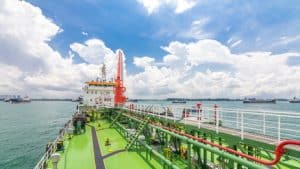What Is a Deck?
It’s a permanent covering over a hull or compartment of a ship. On any ship or boat, the upper or primary deck is typically the horizontal structure forming the hull’s roof, making it strong and acting as a primary working surface. Vessels usually have more than 1 level, both in the superstructure that’s above the primary deck and within the hull. Decks have specific names for some purposes.
The main purpose of a primary or upper deck is structural, and only as a secondary factor, to provide weather-tightness plus support equipment and people. The deck works as the complex box girder’s (hull) lid. It resists compression, tension and racking forces. Usually, the deck’s scanting is just the same as all the topsides, or it could be heavier in case the deck will be carrying heavier loads (for instance, container ships). The deck is going to be reinforced around the fittings of the deck like bollards, cleats or capstan.
On ships that have more than 1 level, deck means the level itself. The exact floor surface is known as the sole, and deck refers to any structural member tying the ribs or frames of the ship together over the keel.
How Decks Emerged and Evolved
When ships were only trading relatively locally, they tend to have no decks. Literally, they were simply “empty vessels” where cargo was loaded. It was not until the Romans and Greeks started ranging further around the Mediterranean as well as beyond that they required a covering over the hull and hold.
With Romans galleys being powered by slaves who were rowing, there was a need to protect them from the elements and contain them so that they don’t escape. Therefore, a deck allowed all of these things. Also, it provided more space for fighting men and those on board. The Romans and Greeks were also known to be great maritime trading civilisations, hence they used to load their vessels with cargo. That means they also needed protected areas where they could keep all their goods protected.
Building It Up
The deck idea wasn’t embraced by all renowned seafarers. For instance, Viking long ships were open to the environment. The reason was partly that they drew a shallow draft, allowing the Vikings to be capable of heading up shallow rivers and then hit their victims deep into their territory.
For the Norse seafarers, the idea of building another structure and an extra deck would have made their long ships unstable, and that could have cost them an important tactical advantage. They were also only trading relatively locally, so they had to make a cost-benefit analysis, and that’s how the ship design that doesn’t have a deck won out.
That’s an important issue because the design that didn’t come with a deck eventually meant that their long ships couldn’t grow beyond certain sizes. Meaning that since the strains and stresses were not “tied together”, anything that was over 30 metres started to bend too much.
Furthermore, the crew on the Viking long ships were always exposed to the elements because the ships didn’t have decks. Therefore, despite being incredibly hardy, the Norsemen must have encountered incredibly sapping conditions. Especially the fact that the Vikings ranged up to North America. That means without a deck, these Norse seafarers were making their life harder, and they were compromising their vessel designs from evolving.
A Design For Life
Consequently, the vessel types that chose to embrace the deck design conquered the world through trade. Whereas the Vikings needed vessels that are smaller and tactical, the great trading civilisations saw that they needed protection and cargo space and also a way of growing.
Weather decks evolved from often having structures fore (front or forward) and rear (aft) of the ship clear. In the nineteenth century, wheelhouses/pilothouses and deck houses started to appear, ultimately developing into the modern ship’s superstructure
A deck is essential to the vessel rigidity, and it makes perfect sense in making sure ships are rigid enough, it’s capable of dealing with water breaking anytime over the bow or with precipitation. Also, the deck becomes a surface for bolting machinery to and a platform for operations.
Equipment mounted on the deck (like fife rails, binnacle and ship’s wheel) may be collectively called deck furniture. It’s become a way of protection, plus a key strength member to devise a box girder design, which is known today. With a sheer that draws water away and a way of closing all openings, the deck provides the ideal solution in ship design and naval architecture. It’s an elegant solution that’s multi-functional and vital.
Since efficiency and safety are of great importance during any marine cargo handling operation, nowadays there are anti-skid systems, which are safe surfacing solution for the pure car and truck carriers (PCTCs) ramps and roll-on/roll-off (RoRo) vessels. Many ship owners consider them to be an excellent alternative to conventional welded bar systems. They provide safes and most efficient solution for discharging and loading vehicles, even in wet conditions.

